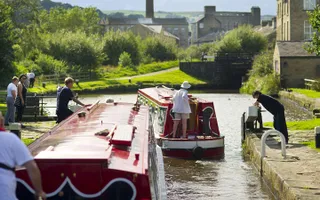We’re happy to enter into discussions, with applicants/developers and local planning authorities (LPAs) to overcome our concerns. We encourage pre-application discussions so that issues and potential mitigation can be highlighted early in the process.
Planning conditions
Conditions can be used to secure measures to protect the physical infrastructure of the waterways. For example, requiring the submission of details of excavation works, foundation design and construction methods for approval by the LPA or the undertaking of investigatory work to identify where mitigation work is required and ensure that it is carried out.
Conditions can also be used to ensure that detailed schemes for drainage systems, hard and soft landscaping etc. are provided for approval by the LPA, and that implementation of these schemes is required as part of the development.
We consider how our requests for planning conditions satisfy the relevant tests set out in the National Planning Policy Framework and guidance in the National Planning Practice Guidence. We’re always happy to discuss the wording of proposed planning conditions to ensure that they’re fully effective.
Applicants should consider including the waterway and/or towpath within the application site red line as this can facilitate the use of conditions to address issues that may otherwise lead to an objection.
Planning obligations
Planning obligations under Section 106 of the Town and Country Planning Act 1990 (as amended), are a way to make a development proposal acceptable in planning terms, that would not otherwise be acceptable.
We may advise that a planning obligation is required when we respond to planning consultations. Where we ask for a planning obligation, we’ll seek to set out how our request complies with the tests set out in regulation 122 of the Community Infrastructure Levy Regulations 2010 (as amended).
In a waterway context planning obligations are most commonly used to secure off-site works such as towpath upgrades, where development proposals will encourage, or rely upon, use of the towpath as a sustainable walking/cycling route connecting new development with the surrounding area.
Community Infrastructure Levy (CIL)
Where LPA’s have introduced CIL, we’ll aim to identify and highlight any conflict between potential planning obligation requests and the infrastructure works identified on the LPA’s Community Infrastructure Levy regulation 123 list as being able to benefit from CIL contributions.
We encourage LPAs to consider carefully whether works to waterway infrastructure will be inadvertently covered by more generic descriptions of infrastructure works on regulation 123 lists, for example as ‘Green Infrastructure’. This may prevent planning obligations being secured for waterways. Precise definitions within regulation 123 lists can avoid such unintended consequences.
Informatives
We frequently ask for informatives and advisory notes to be attached to planning application decision notices. These tend to cover matters that may affect us as owner of a waterway or associated structures, or to highlight and encourage good practice which will help minimise adverse impacts on the waterways and their users. As a landowner there are various different consents and agreements our teams deal with:




